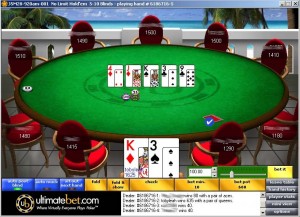Multi Day Poker Tournament Strategy
(This article is a follow up to 'Bubble Tournament Strategy')
The late stages of a tournament begins when the money bubble bursts, and ends when players reach the final table (or final few tables, if it is a really large tournament). Your play during this stage of the tournament should change drastically, as you have now made the money and have the opportunity to climb in the payouts.
During the late stages, blinds will be placing immense pressure on almost everyone's stack, save for the chip leader. Once again, the most important factor in determining your correct style of play is your stack size, so we have written guides for playing the late stages with a short stack, an average stack, and a large stack.

You can finally see the finish line, so make sure to follow the strategies below to reach the final table and win a huge pay day:

This is a discussion on 2 day tournament strategy within the online poker forums, in the Tournament Poker section; Hi all, I quilified for the $27L $600kgtd SCOOP 2 day event on Sunday. Players who have solid poker fundamentals will often make a major mistake in poker tournaments that they don't make in cash games. That mistake is being too patient. In a cash poker game, the goal (especially at low limits) is often to wait for a good hand, a good flop and a. I usually will play their lower limit daily tournaments and the 1/3 cash games every once in a while. I plan on playing in the opening event, a 2-day, $360 buy-in with 5 day one flights and it is the first multi-day tournament that I’ll be entering. Should I be approaching a multi-day tournament any differently than I would a single day. Multi-table poker tournaments (also known as MTT's for short) of all field sizes and buy-in levels can be found online 24 hours a day. This article will cover basic multi-table tournament strategy at the various stages that a tournament will go through before the lucrative final table. The top 5 strategies for novice poker players,. Multi Day Poker Tournament Strategy, littlewoods gambling, lucky red casino no deposit bonus 2017, roulette de manutention charge lourde. Welcome Bonus $1,000. Betway Casino App. It's simple interface and choice of more than 100 games makes the Betway casino app a.

Playing the Short Stack in the Late Stages
At this stage in the game the short stack is actually the simplest stack to play, because you only have two moves: all-in or fold. A short stack is any stack that only has ten or less big blinds. You can only last one or two rounds without making a play, so you need to be on the lookout for opportunities every single hand.
Although you only have two plays, you can use them in strategic ways to build your chip stack. When you are in late position, you should be pushing all-in whenever the table folds to you in order to steal the blinds. Also, if a couple players limp in you can try a squeeze play by raising all-in with the hopes that everyone folds. And it goes without saying that you are pushing all-in with any pocket pair or any two face cards, regardless of position.

If you are in the small blind and everyone folds to you, you should be going all-in the majority of the time because the big blind is very likely to fold. By stealing in late position, occasionally squeezing, and stealing from the small blind, you can pad your stack and build back up to an average-sized stack.
Playing the Average Stack in the Late Stages
Playing an average stack during the late stages of a tournament is a lot more difficult than playing an average stack at the start of a tournament, because the enormous blinds and antes will place far more pressure on your stack. Players with an average stack can steal, re-steal, and squeeze, but should avoid going all-in from the small blind, as you don't need to do that yet. In addition, average stacks should look to get all-in preflop in favorable situations.
Playing coin flips against smaller stacks is a good opportunity to build your stack. Short stacks will push all-in with marginal hands, so you can make calls with a wide variety of hands and still be ahead. If a short stack pushes all in, feel free to call them down with any pocket pair, or any two big cards. You will almost always either be ahead or be in a coin flip situation, so it is a profitable move overall.

Playing the Big Stack in the Late Stages
Big stacks should follow a similar strategy to the middle stacks during the late stages: steal from late position, re-steal occasionally, squeeze when it is appropriate, and call all-ins when you think you are ahead. However, with a big chip stack you can do all of those things, but more aggressively.
Depending on how badly you need a big pay day, you can vary your aggression. If you want to go for the win and can afford to place outside of the final table, go with a super aggressive approach and try to become the overall chip leader of the tournament. If you really need a final table finish and don't want to take a risk, you can take a more passive approach that will guarantee you a nice score.
Regardless of your approach, you should never be limping in as the big stack - either fold or raise. If you are going to call another player's all-in, make sure that you can comfortably afford to lose the hand. If the other player has big chip stack you better have a solid hand, because you are basically gambling with your tournament life.
Now that you know how to play the late stages, learn how to play the final table.